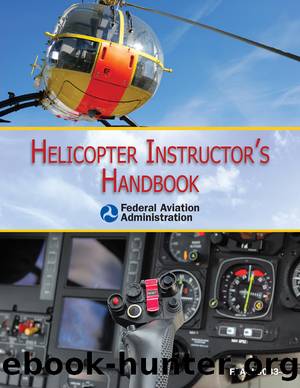Helicopter Instructor's Handbook by Federal Aviation Administration

Author:Federal Aviation Administration
Language: eng
Format: epub
Publisher: Skyhorse
Published: 2014-01-01T00:00:00+00:00
Crosswind Considerations During Takeoffs
When the takeoff is made during crosswind conditions, the helicopter is flown in a slip during early stages of the maneuver. In this case, the cyclic is held into the wind a sufficient amount to maintain the desired ground track for the takeoff. The heading is maintained with the use of the antitorque pedals. In other words, the rotor is tilted into the wind so the sideward movement of the helicopter is just enough to counteract the crosswind effect. To prevent the nose from turning in the direction of the rotor tilt, it is necessary to increase the antitorque pedal pressure on the side opposite the rotor tilt.
After approximately 50 feet of altitude is gained, crab the helicopter into the wind as necessary to maintain coordinated flight over the desired ground track. The stronger the crosswind, the more the helicopter has to be turned into the wind.
Download
This site does not store any files on its server. We only index and link to content provided by other sites. Please contact the content providers to delete copyright contents if any and email us, we'll remove relevant links or contents immediately.
Pale Blue Dot by Carl Sagan(4890)
Cracking the GRE Premium Edition with 6 Practice Tests, 2015 (Graduate School Test Preparation) by Princeton Review(4211)
Pocahontas by Joseph Bruchac(4169)
Unfiltered by Lily Collins(3948)
The Emotionary: A Dictionary of Words That Don't Exist for Feelings That Do by Eden Sher(3304)
The Daily Stoic by Holiday Ryan & Hanselman Stephen(3216)
Factfulness_Ten Reasons We're Wrong About the World_and Why Things Are Better Than You Think by Hans Rosling(3189)
The President Has Been Shot!": The Assassination of John F. Kennedy by Swanson James L(3036)
The 48 laws of power by Robert Greene & Joost Elffers(2996)
Sapiens and Homo Deus by Yuval Noah Harari(2971)
Rogue Trader by Leeson Nick(2963)
The Innovators: How a Group of Hackers, Geniuses, and Geeks Created the Digital Revolution by Walter Isaacson(2788)
The Rape Of Nanking by Iris Chang(2765)
Gettysburg by Iain C. Martin(2723)
Almost Adulting by Arden Rose(2648)
The Plant Paradox by Dr. Steven R. Gundry M.D(2532)
500 Must-Know AP Microeconomics/Macroeconomics Questions(2521)
In the Woods by Tana French(2521)
Make by Mike Westerfield(2275)
